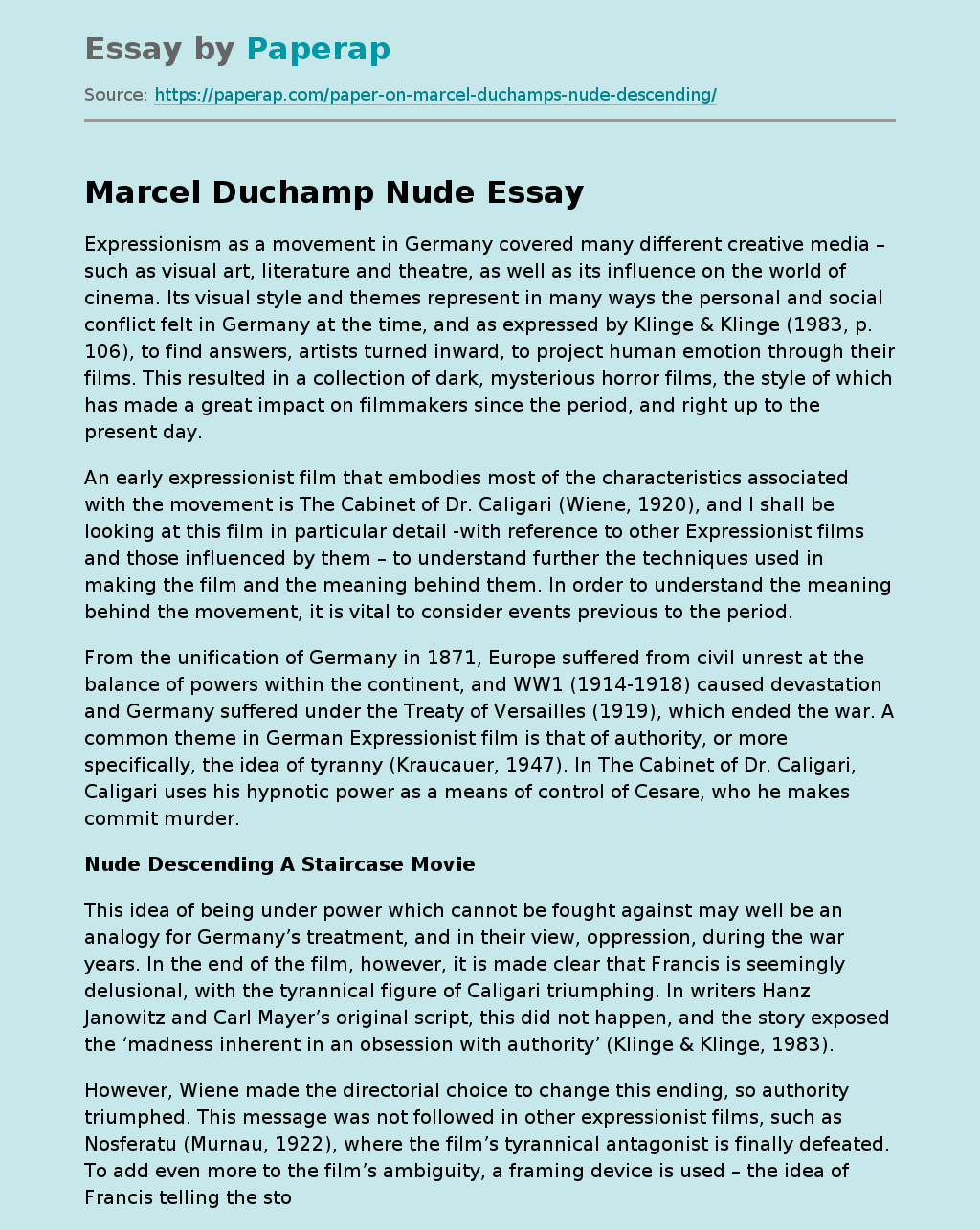Expressionism as a Movement in Germany
The following example of an essay is about expressionism as a movement in Germany. Read the introduction, body and conclusion of the essay, scroll down.
Expressionism as a movement in Germany covered many different creative media – such as visual art, literature and theatre, as well as its influence on the world of cinema. Its visual style and themes represent in many ways the personal and social conflict felt in Germany at the time, and as expressed by Klinge & Klinge (1983, p.
106), to find answers, artists turned inward, to project human emotion through their films. This resulted in a collection of dark, mysterious horror films, the style of which has made a great impact on filmmakers since the period, and right up to the present day.
An early expressionist film that embodies most of the characteristics associated with the movement is The Cabinet of Dr. Caligari (Wiene, 1920), and I shall be looking at this film in particular detail -with reference to other Expressionist films and those influenced by them – to understand further the techniques used in making the film and the meaning behind them.
In order to understand the meaning behind the movement, it is vital to consider events previous to the period.
From the unification of Germany in 1871, Europe suffered from civil unrest at the balance of powers within the continent, and WW1 (1914-1918) caused devastation and Germany suffered under the Treaty of Versailles (1919), which ended the war. A common theme in German Expressionist film is that of authority, or more specifically, the idea of tyranny (Kraucauer, 1947).
In The Cabinet of Dr. Caligari, Caligari uses his hypnotic power as a means of control of Cesare, who he makes commit murder.
Nude Descending A Staircase Movie
This idea of being under power which cannot be fought against may well be an analogy for Germany’s treatment, and in their view, oppression, during the war years. In the end of the film, however, it is made clear that Francis is seemingly delusional, with the tyrannical figure of Caligari triumphing. In writers Hanz Janowitz and Carl Mayer’s original script, this did not happen, and the story exposed the ‘madness inherent in an obsession with authority’ (Klinge & Klinge, 1983).
However, Wiene made the directorial choice to change this ending, so authority triumphed. This message was not followed in other expressionist films, such as Nosferatu (Murnau, 1922), where the film’s tyrannical antagonist is finally defeated. To add even more to the film’s ambiguity, a framing device is used – the idea of Francis telling the story from inside the asylum (although we only really realise this in retrospect).
The device shows audiences that the events seen are simply Francis’ interpretation, and leaves an uneasy feeling of not being sure what to believe – a murderer getting away with his crime, or Francis being simply delusional. This idea of the world being disjointed and confusing is shown within the mise-en-scene of the films, as part of the sets. The sets, designed by three expressionist artists – Walter Reimann, Walter Rohrig and Hermann Warm – use sharp edges and jagged lines, such as the style of the houses in The Cabinet of Dr. Caligari, which are set at angles with sharp corners.
These sets are often representative to paintings within the Expressionist movement in visual arts, which feature the same angles and distorted perspective, for example, Marcel Duchamp’s ‘Nude Descending a Staircase’ (1912), in which the nude and the staircase are represented abstractly, not in any kind of naturalistic way. These kinds of sets have made clear influence on more recent films, a particular director using the style being Tim Burton. An example of this is in his film Sleepy Hollow (1999); the trees in the forest backdrop are dark and jagged, with pointed ends.
In the film, protagonist Crane experiences feelings of madness, and as with Expressionist film, the disjointedness of the sets represent these feelings. Another example of Burton’s homage to Expressionist film is the set design on Batman Returns (1992), in which the long shots of Gotham City are reminiscent of those seen in Metropolis (Lang, 1926), with tall, looming buildings that seem oppressive to those below them. The acting in Expressionist cinema also contributes to the overall style of the film.
Due to these films being made in the silent era, before the discovery of sound, much of the actors’ emotion was shown through their over the top expressions and gesture, and they often moved in a non-naturalistic way and ‘attempted angular postures and jerky movement [… ] to reinforce the theme of a society out of kilter’ (Klinge & Klinge, 1983). The representations of people within Expressionist paintings were also distorted, such as in Edward Munch’s ‘The Cry’ (1893), and as with the sets, these representations seemed to have an influence on the characterisation in the films.
Expressionism as a Movement in Germany. (2019, Dec 05). Retrieved from https://paperap.com/paper-on-marcel-duchamps-nude-descending/

